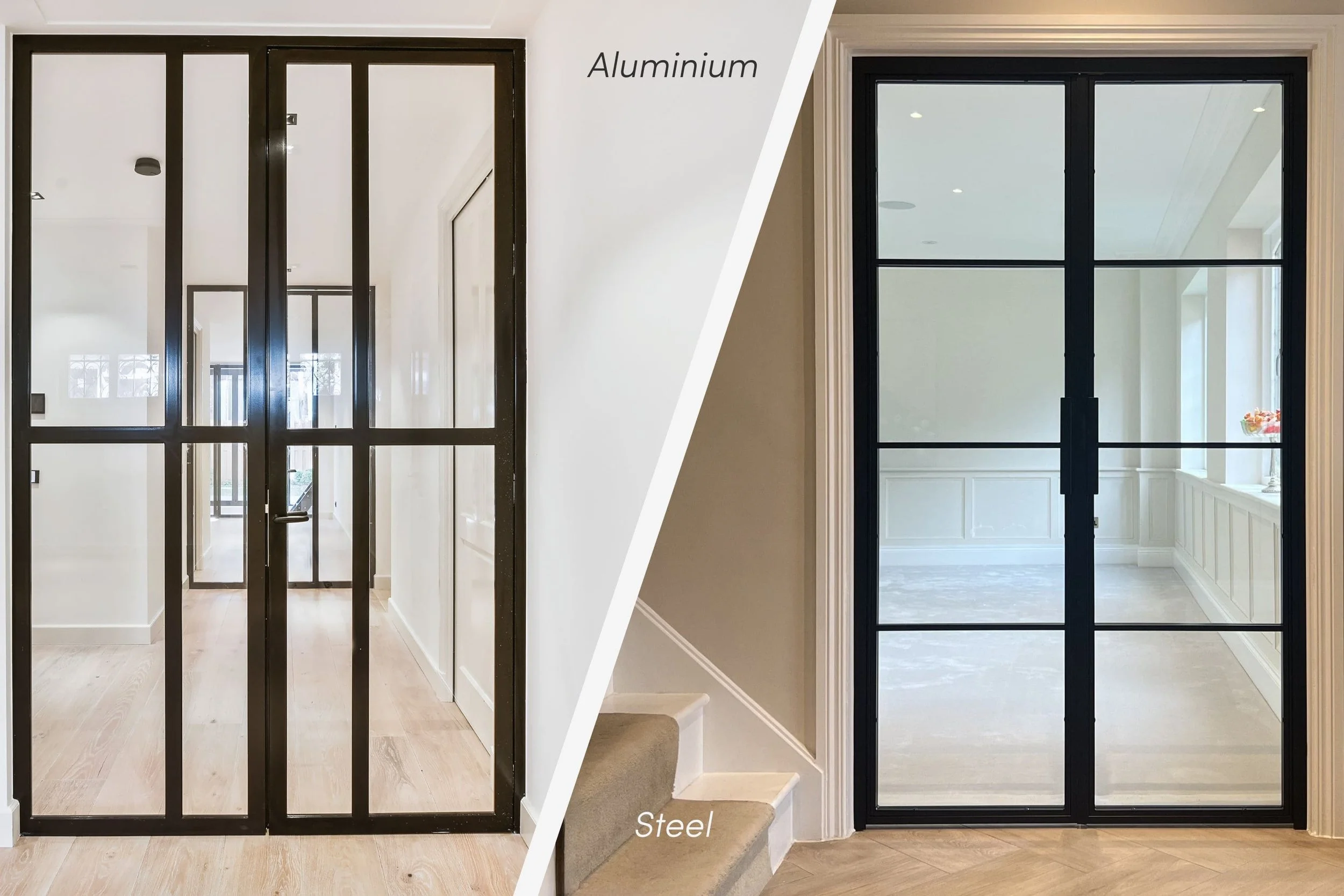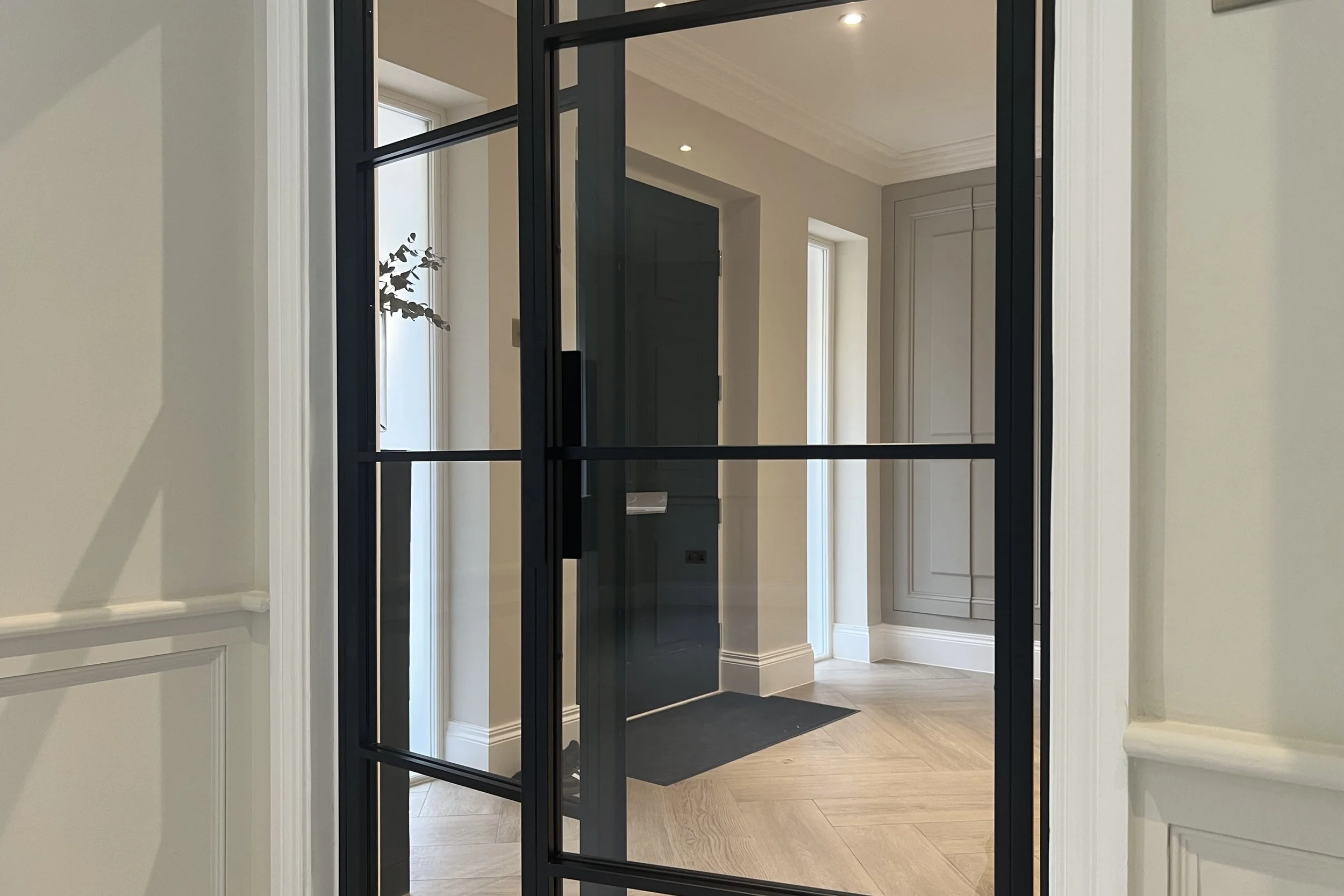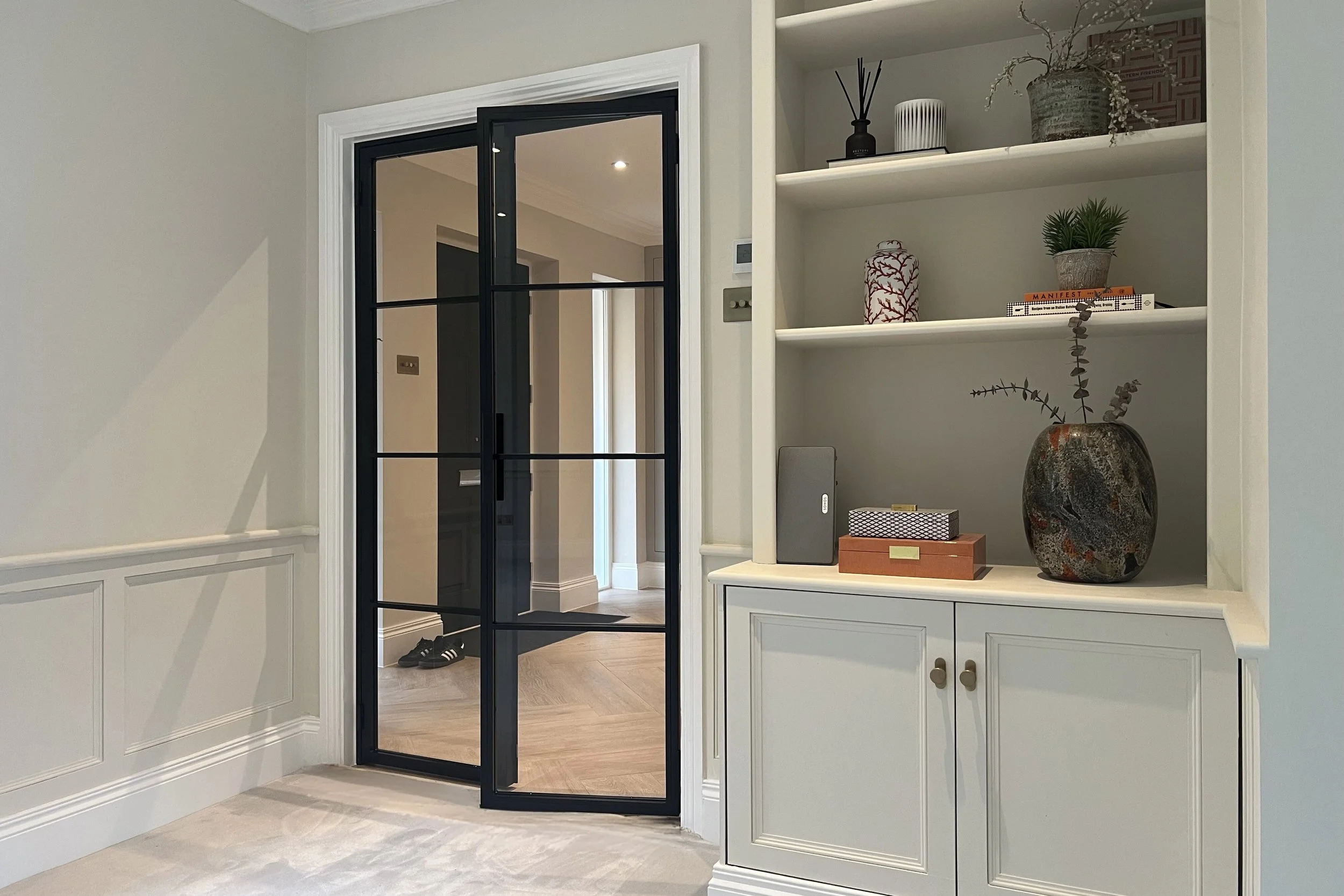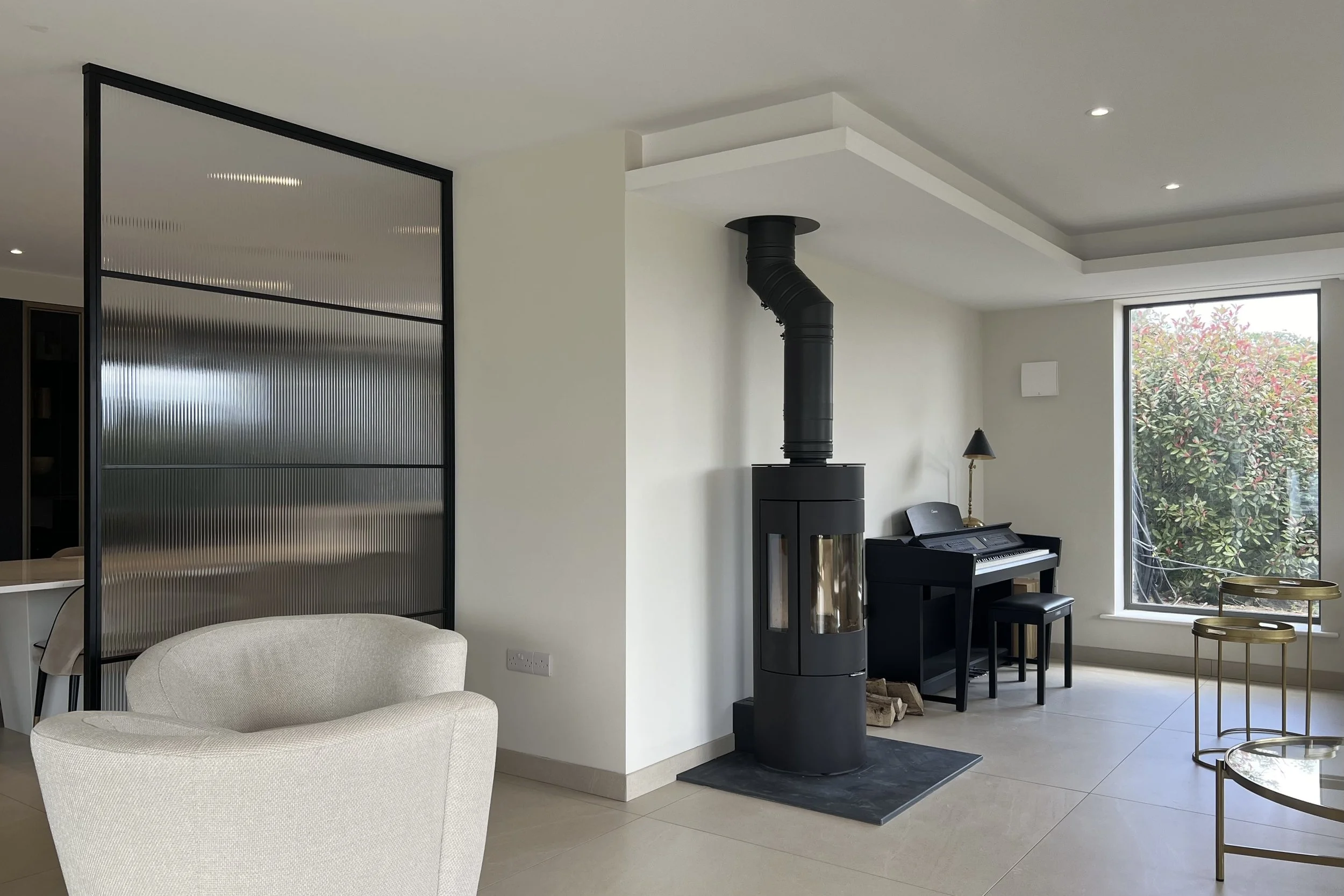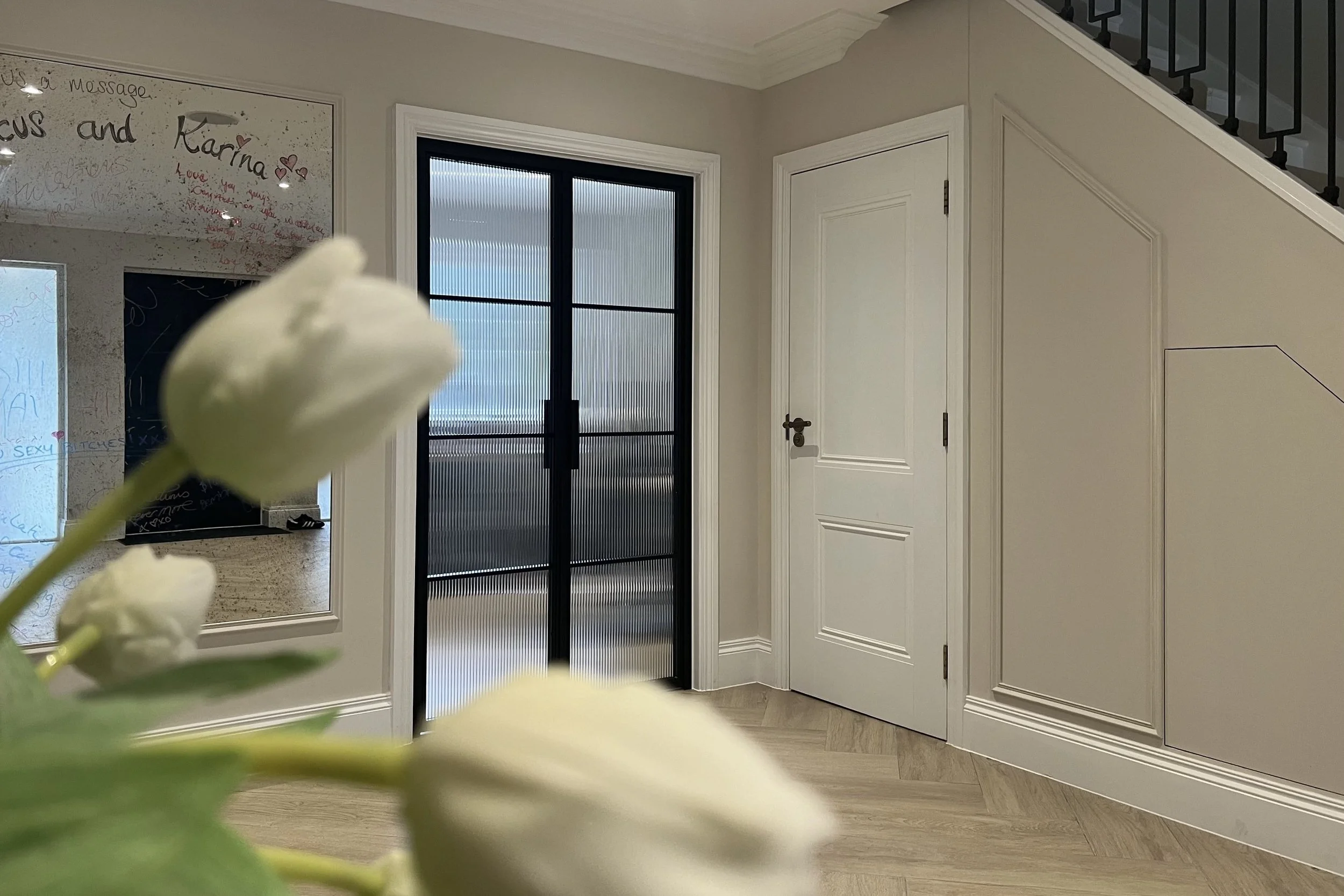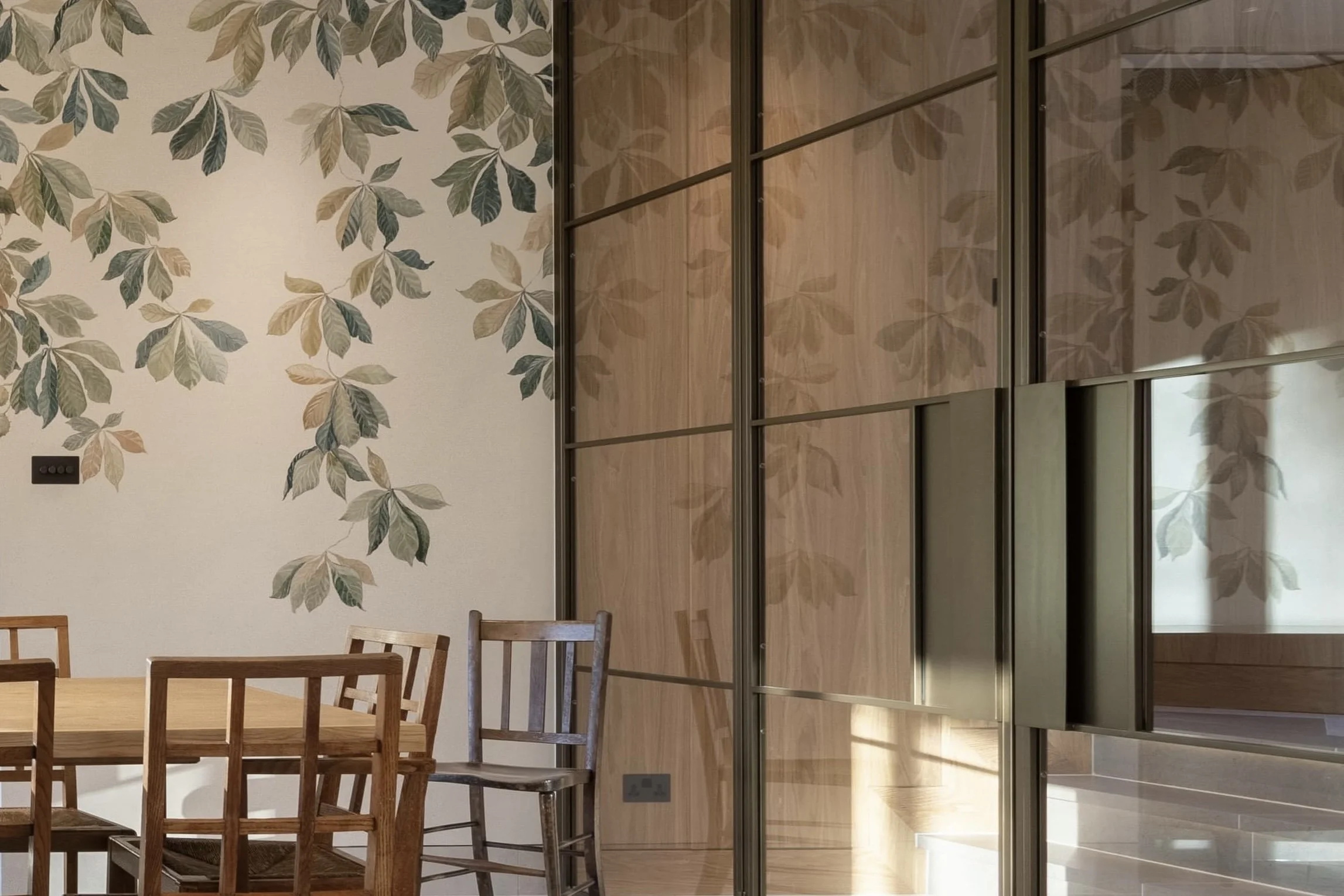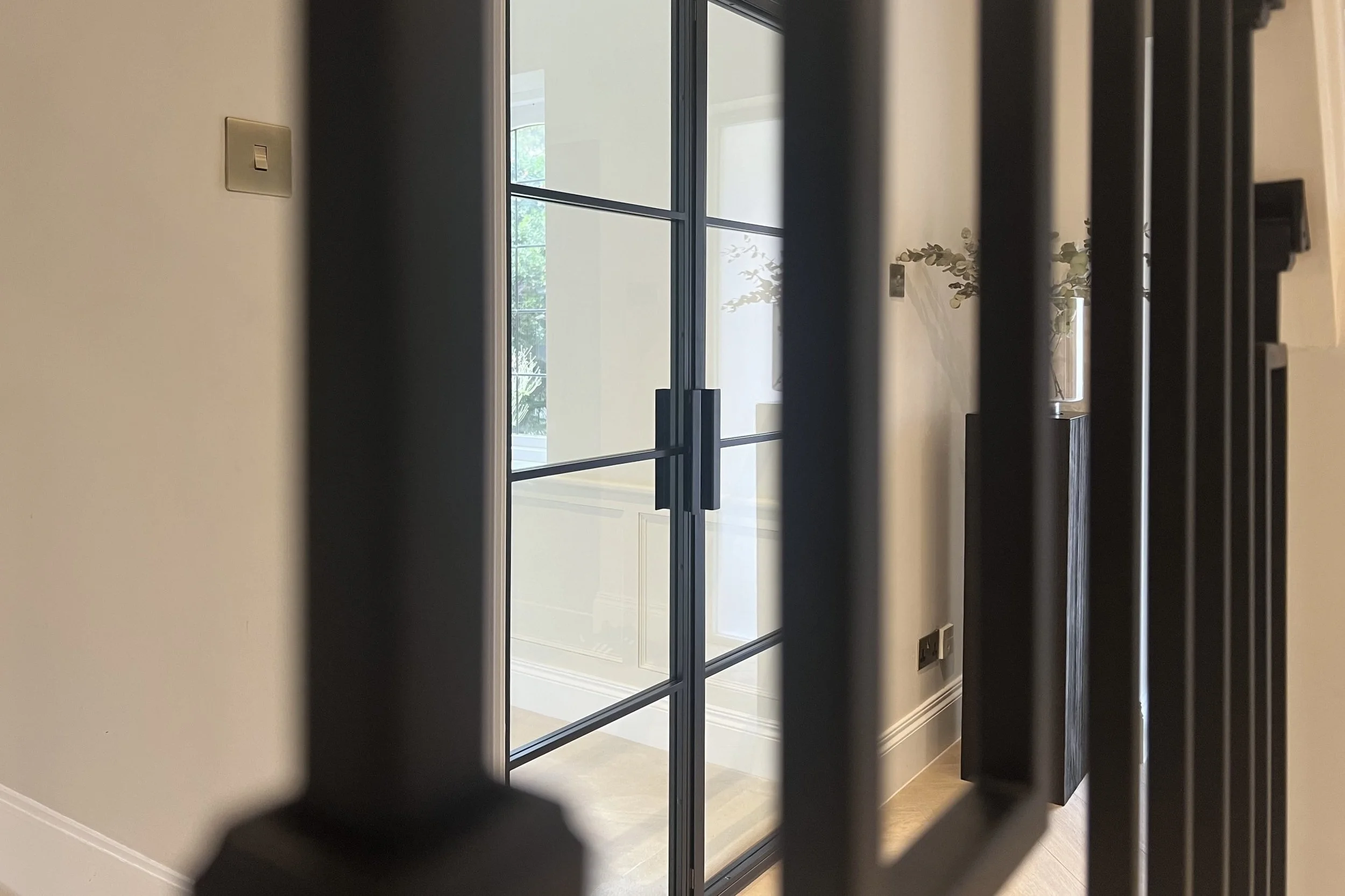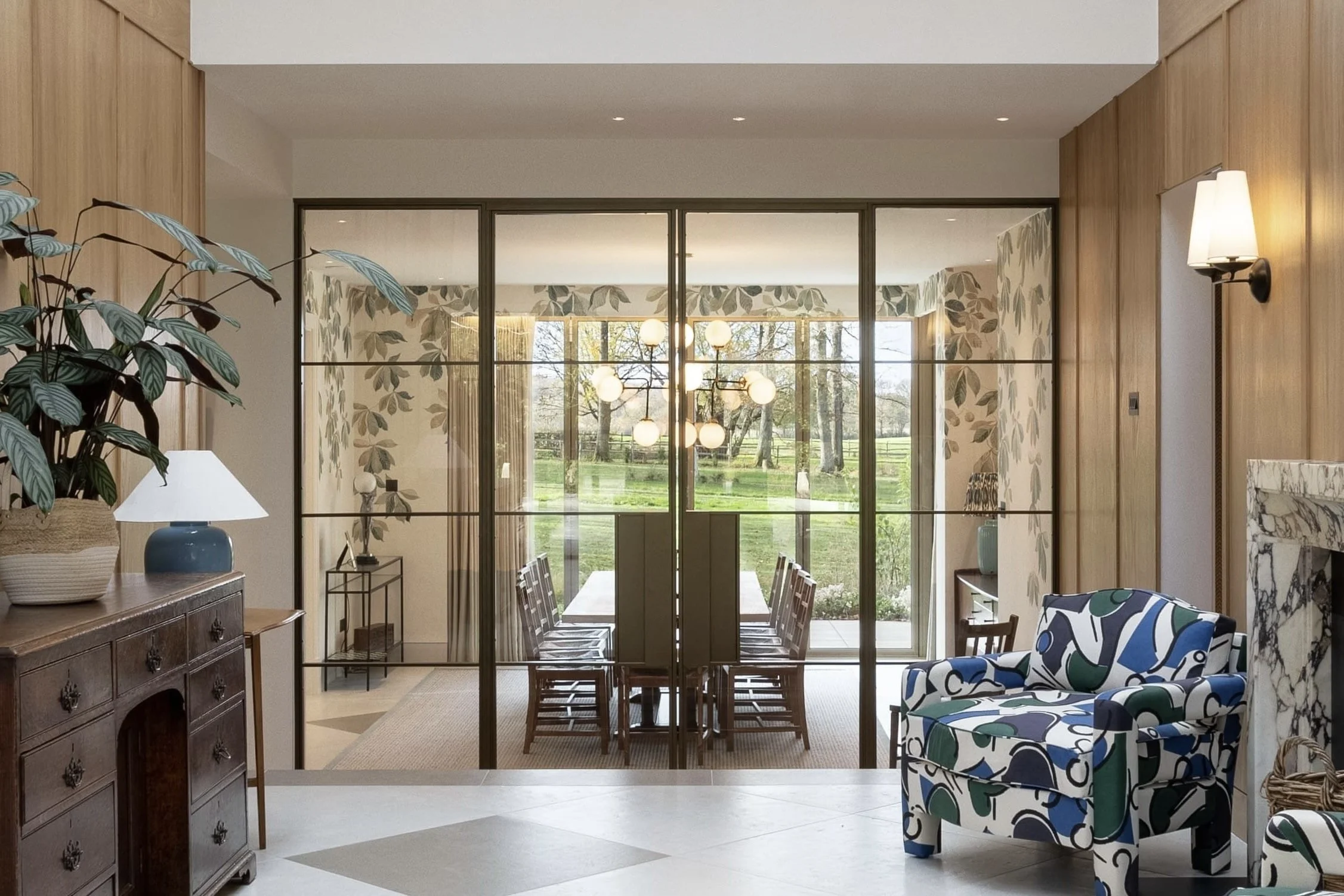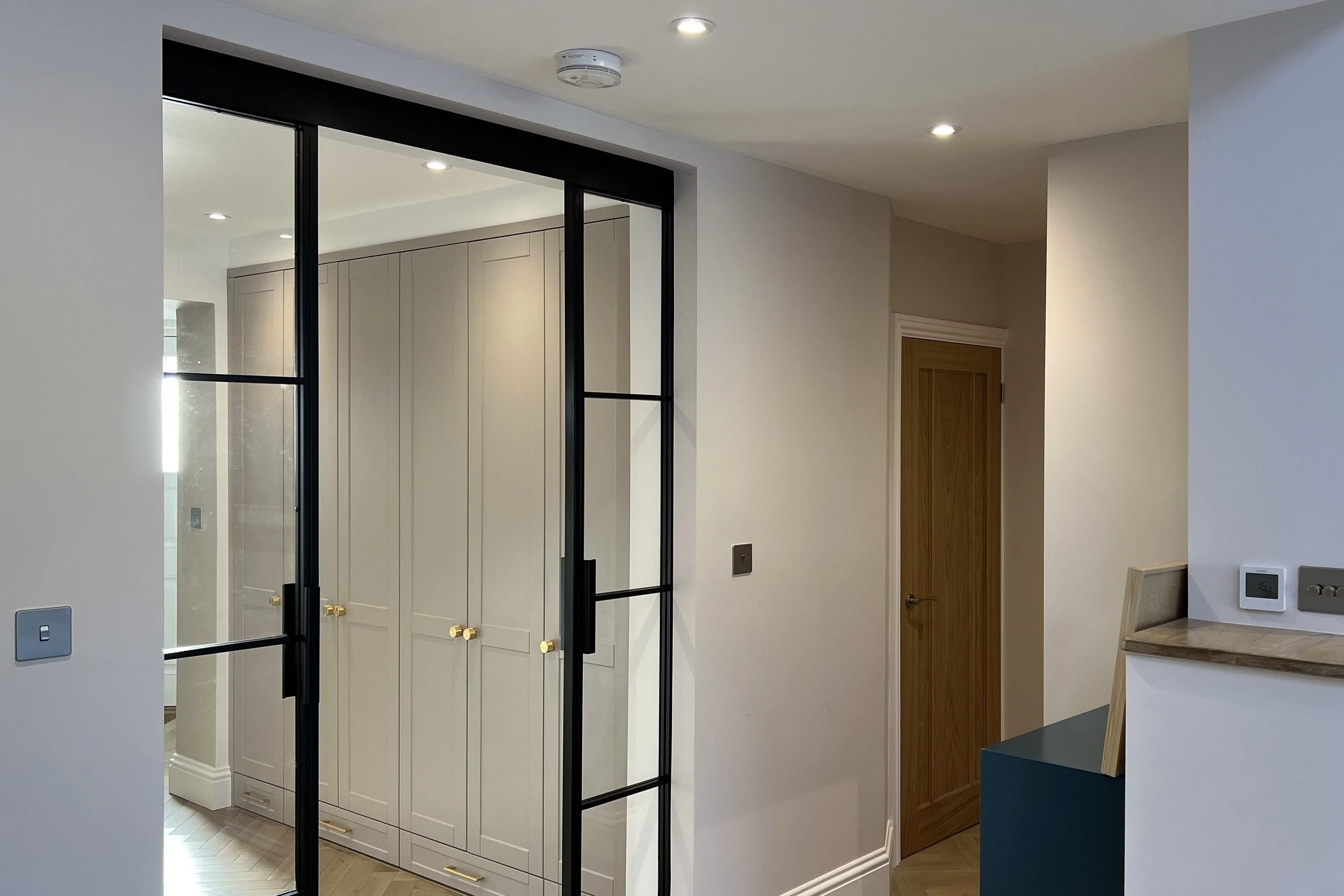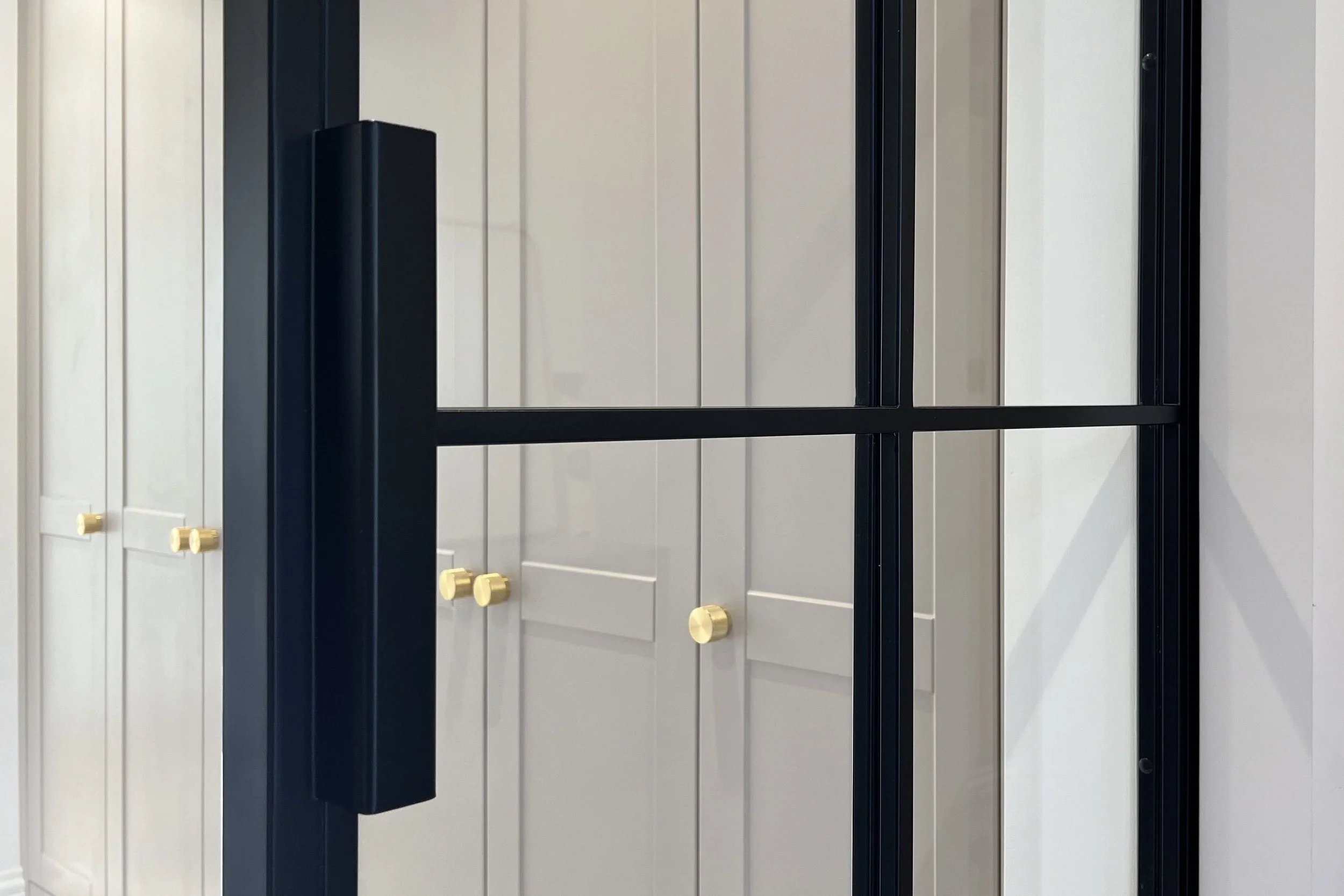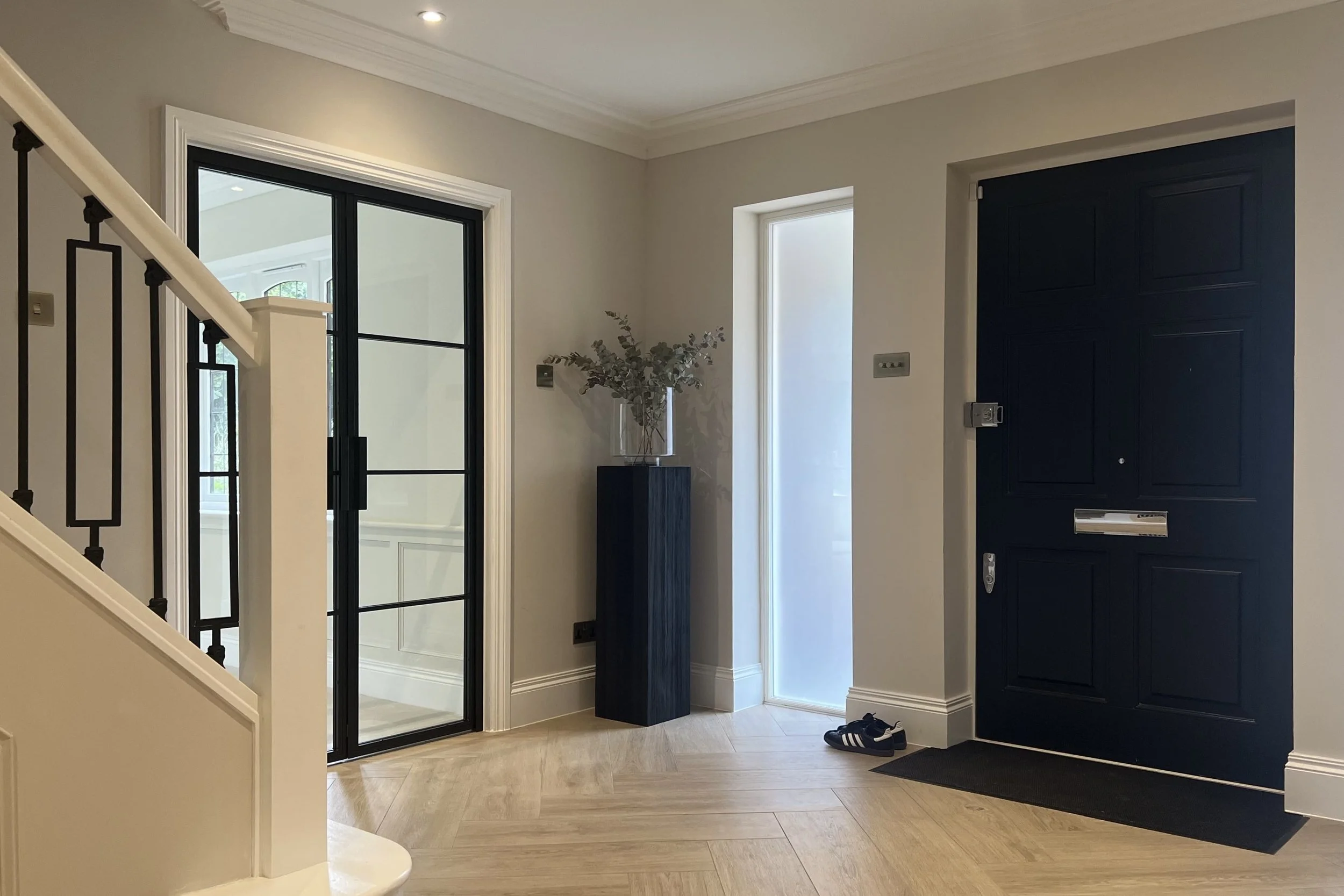Why Steel Doors Outperform Aluminium “Steel-Look” Alternatives
Introduction
The popularity of slim, glazed internal doors has led to a wave of aluminium products marketed as “steel-look.” On first glance, they can seem similar: dark frames, horizontal and vertical bars, glass. But when installed, lived with and photographed, the differences quickly show—especially in luxury homes where detail, longevity and tactility matter.
This article explains, clearly and practically, why true steel internal doors outperform aluminium imitators across the criteria that count: sightlines, fabrication and stability, operation and feel, design freedom, acoustic and fire considerations, finish quality, maintenance, and long-term value. Along the way, we’ll point to relevant options from the Joshua James collection so you can specify with confidence.
Sightlines & Proportion: Real Slimness vs. “Slim-ish”
Steel’s inherent strength allows genuinely slim profiles while still supporting large panes of glass. That means more light, fewer visual interruptions, and refined geometry that reads “architectural” rather than “kit-based.”
Aluminium, by contrast, relies on extruded sections for strength. Even so-called slim systems often require deeper or bulkier profiles—particularly at corners, meeting stiles and hinge points. The result can be thicker borders and inconsistent junctions that disrupt sightlines.
Where this matters most:
Hallways and entrances: where the frame outlines are clearly silhouetted against daylight.
Open-plan zones: where clean alignment of bars and mullions keeps the space visually calm.
Full-height doors: where any added bulk is obvious and dilutes the elegant verticality.
If you’re planning a minimal layout, choose steel for guaranteed slenderness and proportion.
Explore configurations:
Fabrication & Stability: Welded Frames vs. Screw/Clip Assemblies
A true steel internal door is welded into a single, unified frame. Corners are mitred and fused; bars meet precisely; there are no mechanical joints to loosen over time. That solidity is obvious the moment you open the door.
Most aluminium “steel-look” products are screw- or clip-together assemblies. In practice, high-traffic use can introduce micro-movement at joints, leading to creaks, dropped leaves, misalignment at keeps, or visible gaps at intersection points. Over years, these systems often need periodic tweaks or part replacements.
Why welded matters:
Longevity: geometry holds; doors keep their fit.
Precision: clean intersections and flush surfaces.
Tolerance: better resistance to daily use and temperature changes.
For tall doors, double sets, and any opening that will be used constantly, welded steel remains the gold standard.
Consider for heavy-use areas:
Tactility & Operation: The Feel of Quality
People don’t just see a door—they feel it. The weight, damping and closure of a steel door communicate quality immediately: it swings with intent, latches cleanly, and feels planted. Aluminium imitations often feel light or hollow, sometimes relying on bulkier hinges or visible seals that distract from the minimal aesthetic.
In premium interiors, users notice:
The reassuring resistance as the door moves.
The quiet closure without rattle.
The solid latch engaging with accuracy.
This tactile experience is part of why steel is so often specified by architects and interior designers for high-end work.
Match operation to use-case:
Steel Single Doors for studies, dressing rooms, snugs
Double Door Sets for entertaining spaces
Sliding Systems for footprint-sensitive layouts
Design Freedom: Bespoke, Not “Best-Fit”
True steel fabrication is inherently bespoke. You can control frame size, bar layouts, handle positioning, junctions with fixed screens, corner returns, and pocket integrations—with confidence that the frame will remain stable at scale.
Aluminium lookalikes, by contrast, often come as modular kits. You can adjust height and width within the catalogue, but there’s far less freedom over bar pattern, sightline alignment, handle location, and complex junctions such as 90°/135° screens or pocket sliders that need flush handles.
If a space calls for made-to-measure elegance—think full-height doors, long runs of glazing, or an asymmetric bar layout that tracks with cabinetry—steel excels.
Plan bespoke assemblies:
Glazing, Acoustics & Privacy: Light Without Compromise
Internal doors aren’t just visual; they manage light, sound and privacy. With steel, you can specify:
Clear glass for maximum openness and borrowed light.
Reeded or frosted glass to soften views while keeping spaces bright.
Laminated acoustic glass to reduce noise transfer between kitchen, living and study areas.
Aluminium systems can use similar glass types, but thicker profiles and additional seals or cover caps often dilute the pared-back aesthetic and can introduce rattles over time.
For WFH (work from home) offices, snug lounges, nurseries or media rooms, steel lets you tune the balance between light and quiet—without visual clutter.
See also:
Fire-Rated Options: Safety With Style
Where a rated partition or door is required, steel offers tested fire-rated systems that maintain elegant sightlines. The non-combustible nature of steel and the availability of certified assemblies make it the material of choice for style-conscious safety.
Aluminium lookalikes typically cannot replicate the same rated aesthetics internally without significant compromises to profile depth and appearance—or are simply unavailable in comparable configurations.
If your project needs rated doors or screens without sacrificing design integrity, choose steel.
Learn more:
Finishes & Detailing: Depth, Texture, Permanence
Steel frames accept exceptional finishing: deep black powders, warm ivories, metallics such as bronze or aged brass, and precision textures that feel premium up close. Welded corners allow flush transitions and consistent edges; welded handles (where specified) appear truly integrated.
Aluminium extrusions can be powder coated, but surface depth and edge crispness rarely match the carved-from-metal quality steel delivers. Over time, exposed caps, end plates or screws can age less gracefully than seamless welded steel junctions.
For close-up perfection, choose steel.
Relevant collections:
Maintenance & Longevity: Built to Last
Welded steel frames hold their geometry. Hinges remain true, keeps align, and bars stay flush. With appropriate care, a steel internal door can perform for decades without the fatigue often associated with screw-together systems.
Many aluminium lookalikes develop play at joints, rely on replaceable seals and clip covers, and can require periodic re-square or hardware updates to keep them feeling tight. In a busy household or a long-term luxury property, that maintenance overhead (and the lived-in feel of loosened joints) undermines the brief.
If you’re building a home to last, consider the total cost of ownership—not just the initial price tag.
Cost vs. Value: The Investment Argument
Aluminium “steel-look” products often appear attractive on upfront cost. But in premium contexts, value is measured over years—in how a door operates, ages, and holds alignment. It’s also measured in buyer perception: steel framed doors signal craftsmanship and permanence that kit-based alternatives struggle to match.
When you factor:
The daily experience (feel, acoustics, closure),
The aging (how they will look and operate in 5/10 years)
The photographic quality (estate listings, design portfolios),
The reduced maintenance and longer lifespan,
…the investment case for steel becomes clear.
Ready to specify?
Where Steel Shines: Real-World Applications
Open-Plan Living
Slim steel room dividers keep zones legible while preserving light and long views. Aluminium’s bulkier meeting points can break the visual calm.
Hallways & Entrances
Double doors frame vistas and pull borrowed light through the plan. This is where genuine sightlines matter most.
Home Offices
Steel single doors with reeded or laminated glass support focus and privacy while staying visually connected to family life.
Space-Saving Layouts
Sliding systems—including pocket doors—offer separation without swing clearance. True steel gives neater junctions and better long-term alignment.
Fire-Compartmentation with Elegance
Where required, fire-rated steel retains the aesthetic—rather than becoming a visual compromise.
Handle & Hardware Integrity
Steel allows for welded handles (where appropriate) such as our Trim or Linear options, creating a purist look with no visible fixings. Lever/latch sets (e.g., Guarded) integrate crisply with the frame and keep geometry tight. On sliding systems, cup handles sit flush for full recess in pockets.
Aluminium systems often rely on surface-fixed hardware that can introduce visible screws, caps or cover plates—small details that break the illusion of minimalism.
Relevant reading: our guide to handle selection (Blog #4).
Meanwhile, explore product fits here:
Sustainability & Lifecycle
A door that lasts decades is inherently sustainable. Steel is highly recyclable and, more importantly, exhibits long service life in internal applications—reducing replacement cycles, waste and embodied energy over time. Aluminium is also recyclable, but many “steel-look” products face earlier maintenance or replacement due to assembly fatigue.
Choosing steel is a choice for longevity and responsibility—without compromise on beauty.
Quick Specification Checklist (Steel vs. Aluminium “Steel-Look”)
Sightlines: Are you seeing true slimness at corners, meeting stiles and hinges?
Fabrication: Welded or screw/clip? What happens after 5–10 years?
Operation: Does it feel solid, quiet, planted?
Glazing: Clear, reeded, frosted, acoustic options without bulky seals?
Fire: Are rated variants available without losing the aesthetic?
Bespoke: Can you align bars, set custom handle positions, welded corner sections and bars?
Finish: Are edges crisp? Any caps or cover plates in prominent views?
Value: What will this look and feel like after thousands of cycles?
When in doubt, test in person. Tactility and finish are impossible to fake.
Book a visit to our showroom to see what our steel doors have to offer your home or upcoming project.
Frequently Asked Questions
Are aluminium “steel-look” doors as slim as true steel?
Not typically. Aluminium systems rely on extruded sections and often need deeper or bulkier profiles at corners, hinges and meeting stiles. Welded steel achieves genuinely slim sightlines with consistent junctions, especially on full-height doors and double sets.
Do welded steel internal doors need more maintenance?
No. Welded frames hold geometry and alignment for the long term. Routine cleaning and periodic hinge/latch checks are usually sufficient, far less tweaking than screw/clip assemblies.
Can I get fire-rated internal doors with slim frames?
Yes, steel offers tested fire-rated doors and screens that retain elegant sightlines. See our options: Fire-Rated Internal Doors.
Which glass types work best for privacy without losing light?
Choose reeded or frosted glass to soften views while keeping spaces bright. For quieter rooms (WFH, media), specify laminated acoustic glass. Explore configurations via: Room Dividers and Steel Single Doors.
Are steel internal doors heavy or noisy to operate?
Well-specified steel doors feel planted and precise, not clunky. Quality hinges, correct seals and calibrated latches give a smooth, quiet action. This is one of the reasons designers prefer steel in luxury projects.
Can steel doors be fully bespoke?
Yes. Steel fabrication is inherently made-to-measure: custom bar patterns, 90°/135° fixed screens, pocket sliding integrations and full-height sets are routine. See: Sliding Steel Systems and Double Door Sets.
What’s the value case? Are steel doors worth the investment?
For high-end homes: yes. You get truer sightlines, welded stability, better tactility, rated options, and lower lifecycle maintenance—all of which photograph and resell well. Start a spec: Enquire Today.
Let’s Talk
Whether you're renovating a home, specifying for a new build, or delivering a luxury interior for a client — we’re here to help.
At Joshua James, we work with architects, interior designers, homeowners and contractors across the UK to design and supply bespoke steel internal doors. Every door is crafted to exacting standards, tailored to suit each project’s vision, and built to stand the test of time.
If you're ready to elevate your next project with precision-made steel framed doors, let’s talk.

